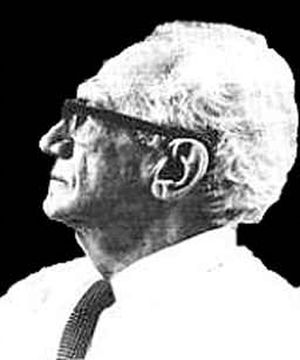Ian C. Johnson ” (1950-1995) was
“Born in 1950 in Halifax, Nova Scotia, Mr Johnson graduated in 1976 from Carleton University, Ottawa, with an honours degree in Political Science. Since graduation he has worked at the National Energy Board, a regulatory body of the Government of Canada. A professional economist since 1982, most of his work has centred around oil and gas supply economics. He attended the McMaster three day symposium on Velikovsky in 1974 and has written for Chiron, SIS Workshop, CSIS Newsletter, Aeon and Catastrophism and Ancient History. He features, along with Prof Tom Henighan, on two 30-minute TV programmes on Velikovsky which were broadcast on Carleton University’s Instructional Television Network as part of a credit course and have been repeated several times, as recently as 1991.”[1]Ian C. Johnson, “Anomalous Occurrence of Crocodilia in Eocene Polar Forests”, SIS Chronology & Catastrophism Review 1992 (Vol XIV)
“He was one of the prime movers behind the founding of the Canadian Society for Interdisciplinary Studies, a group which regularly held symposia, in and around Toronto, to discuss the latest researches in Velikovskian studies. Ian’s interests were wide-ranging, but most of his writings explored various anomalies in geology and paleontology.”[2]”In Memoriam: Ian C. Johnson”, Aeon IV:2 (Aug 1995)
Criticism of Velikovsky
In a letter to Chiron, Johnson wrote:
“To my knowledge, Velikovsky’s citations of C. E. Brasseur de Bourbourg, a nineteenth-century French author on Mesoamerican antiquity, constitute an important faux pas in his use of sources in Worlds in Collision. He is vague on the intellectual link between Brasseur and Fray Diego de Landa, a sixteenth-century cleric who wrote on the native peoples of the Yucatan peninsula. Nowhere in Worlds in Collision does he mention the fact that Brasseur attempted to use de Landa’s arbitrary “Mayan alphabet” to translate Mayan inscriptions and the Troano Codex. Modern scholars agree that this so-called alphabet was a linguistic disaster. The historical or literary content of the books of the Maya remain mostly inscrutable to this day. Reading Velikovsky, it is hard to say whether he was aware of this important bit of historiography. It is possible that he inadvertently left out this necessary background to some of Brasseur’s scholarly works.”[3]”Velikovsky’s Misuse of Mayan Sources”, Chiron: Journal of Interdisciplinary Studies, Winter-Spring 1974
John Myers and Warner B. Sizemore commented in Kronos:
“Mr. Johnson has rightfully pointed out Velikovsky’s error (certainly not a deliberate misuse) but it is quite another matter to prove that he erred in concluding that there existed among the ancient Maya a strong and persistent tradition of repeated cosmic catastrophes. To do that, Mr. Johnson will have to demolish not only Worlds in Collision, the Popol Vuh, and the Chilam Balam, but the Encyclopaedia Britannica as well.”[4]John Myers and Warner B. Sizemore, “Velikovsky, Brasseur, And The Troano Codex”, Kronos” Vol. I No. 1 (Spring 1975)
On Velikovsky’s predictions
A 1981 letter to SIS Workshop, Johnson summarised four recent discoveries which he suggested, confirmed some of Velikovsky’s predictions.[5]Ian C. Johnson, “Confirmation of Dr Velikovsky’s Theories Regarding Electromagnetic and Electrostatic Forces in Celestial Mechanics”, SIS Workshop vol.3 No. 3 (January 1981)
Bibliography
- “Velikovsky’s Misuse of Mayan Sources”, Chiron: Journal of Interdisciplinary Studies, Winter-Spring 1974
- “Confirmation of Dr Velikovsky’s Theories Regarding Electromagnetic and Electrostatic Forces in Celestial Mechanics”, SIS Workshop vol.3 No. 3 (January 1981)
- “Reviews”, C.S.I.S. Members’ Newsletter, Vol. 1, No.1 (January 1982)
- “Science Report”, C.S.I.S. Members’ Newsletter, Vol. 1, No. 2 (March 1982)
- “Derek York’s Radiometric Halo Loses Lustre”, C.S.I.S. Members’ Newsletter, Vol. 1, No. 2 (March 1982)
- “Mankind in Amnesia: A Review”, C.S.I.S. Members’ Newsletter, Vol. 1, No. 2 (March 1982)
- “Hopping in Bed With Dr. V”, C.S.I.S. Members’ Newsletter, Vol. 1, No. 4,
- Chaos and Creation: Review”, C.S.I.S. Members’ Newsletter, Vol. 1, No. 4,
- “Velikovsky as Perceived in Recent Books”, C.S.I.S. Members’ Newsletter, Vol. 2, No. 1 (August 1983)
- “Perspectives on Velikovsky’s Jupiter-Venus Cosmology”, C.S.I.S. Members’ Newsletter, Vol. 2, No. 1 (August 1983)
- “Chaos and Creation: Review”, C.S.I.S. Members’ Newsletter, Vol. 2, No. 2 (August 1983)
- “Yellow Dreadful Velikovsky”, C.S.I.S. Members’ Newsletter, Vol. III, No.1 (April 1985)
- “Book Reviews”, C.S.I.S. Members’ Newsletter, Vol. III, No.1 (April 1985)
- “Anomalous Occurrence of Crocodilia in Eocene Polar Forests”, SIS Review v1992
- “Anomalous Occurrence of Crocodilia in Eocene Polar Forests Part Two”, SIS Review v1993
- “Charles H. Hapgood, Maps of the Ancient Sea Kings”, Aeon vol.3 No.2 (May 1993)
References
| ↑1 | Ian C. Johnson, “Anomalous Occurrence of Crocodilia in Eocene Polar Forests”, SIS Chronology & Catastrophism Review 1992 (Vol XIV) |
|---|---|
| ↑2 | ”In Memoriam: Ian C. Johnson”, Aeon IV:2 (Aug 1995) |
| ↑3 | ”Velikovsky’s Misuse of Mayan Sources”, Chiron: Journal of Interdisciplinary Studies, Winter-Spring 1974 |
| ↑4 | John Myers and Warner B. Sizemore, “Velikovsky, Brasseur, And The Troano Codex”, Kronos” Vol. I No. 1 (Spring 1975) |
| ↑5 | Ian C. Johnson, “Confirmation of Dr Velikovsky’s Theories Regarding Electromagnetic and Electrostatic Forces in Celestial Mechanics”, SIS Workshop vol.3 No. 3 (January 1981) |
